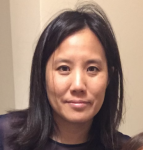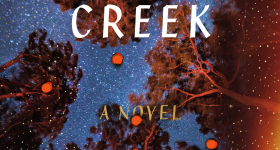James Mattson has a relatable story about finding the premise for his book: “I actually didn’t know that full-contact escape rooms existed until I was scrolling through YouTube videos and the suggestions sidebar gave me a suggestion for a haunted attraction that was full-contact. And so I clicked on it and became obsessed with it. I couldn’t believe it existed.” Mattson (the current Ficton Editor for Hyphen) found the videos an interesting reveal about human nature: “I was just astonished at what people want to endure. It was not that the proprietors were actually inflicting harm on people; it was that the people really wanted to get harmed! And so I was thinking that I wanted to write about this.” Years later, his recently published Reprieve tells the story of four people navigating a full-contact escape room. The book employs an effective formula for horror and true crime dramas, focusing on one event with chapters in between that provide witness testimonies or characters’ backstories. Their backstories contain miniature horrors in themselves where monsters lurk in their past histories (one character engages in the sex trade in Thailand) or contexts where tragic experiences, such as the death of a parent, influence behaviors that could be self-destructive (one character loses her father early on and her actions spiral from that event).
Recently, Mattson and I met on Zoom, where he greeted me from North Dakota to discuss his new novel, Reprieve. Many will tear through this book like they'd run through a haunted maze, with its sudden plot twists and turns, occasional gore and subsequent adrenaline bursts. What compelled me to read the book at a mind-blowing pace was the continued confrontation of the horror of racial otherness and how its fallout became a murder plot. Mattson writes about race issues from the standpoints of white, Black and Asian people — navigating the social dynamics between people with forceful insight. He vividly demonstrates how race alters the fundamental experiences and values of individuals; in his book, one character asks, “How can anyone be good when good and bad are defined by people who’ve categorized you as bad since the dawn of time?” The blurriness of good and evil, transposed onto racialized situations, categorically explode.
"How can anyone be good when good and bad are defined by people who’ve categorized you as bad since the dawn of time?"
On a personal level, Mattson has experienced the dual longing of the Asian American, so his writing comes from a position of having lived it: “I was adopted from Korea, and in my early 30s I went and moved to Korea for a couple of years and reunited with my birth family.” While it was tough, he said, it was a life-altering experience. Mattson explained that he was lucky to be able to connect since his biological sister had married a Russian man and they spoke English together, a luxury that many adoptees often lack when reuniting with their birth families. But he added that the emotional situation of “wanting to be Korean because you’re in Korea and have Korean blood, but not being able to because you don't have the basis to be Korean” was difficult. “I grew up in North Dakota; I’m American through and though.” Mattson’s position of a kind of semi-belonging plurality perhaps contributed to his ability to capture the cultural and linguistic attributes of individuals and write from multiple points of views. Christy is a high school senior, “stuck to the ostentatious and suggestive” in her sartorial choices: “On any given day she’d be a sexy, gory nurse; a sexy, gory cheerleader; a sexy, gory businesswoman; a sexy, gory nun.” And while the outfits were small for the cold weather, people were reticent as “Christy was Christy was Christy.”
Growing up in North Dakota, Mattson says, he read a lot of horror — mainly Stephen King. “I always felt very ostracized growing up here, as an Asian guy struggling with my sexuality, surrounded by white people, white parents, a white brother. … It was very alienating and isolating growing up here,” he says. “I turned to horror because I really liked the idea of the outsider becoming the main player in the novels.” Mattson’s couching of racism in terms of horror resonated with me, as someone who was brought up in Tennessee among a small number of Asian families.
In the American Midwest and South, Asian Americans are in such small numbers that their isolation can make their existence feel like fiction. In Tennessee, my family spoke Chinese and read the Chinese newspaper. Local schools insisted that my mother cease speaking Chinese in our home as my brother, sister and I would answer in Chinese in the classroom. Decisions that affected our lives were others' whims. Being the casualty of such random hate made it difficult to find a sense of order and justice. Bicoastal Asians have more established communities. There are movements in California to establish bilingual or multilingual education in schools and Asians have occupied positions such as mayor or sheriff in California cities — unthinkable in small towns across America. In contrast, in geographic places where the minority population is very small or close to nonexistent, there is often no systematic protection for them and no nuanced articulation of vulnerability. The figures in my formative life who were racist were like horror characters, as they seemed to conjure up some evil power of terror at will, expressing something that the community might deep down harbor towards people like me, people of color. Aside from being intermittently bullied and physically beaten by other kids in grade school on my walks home with my siblings (who took the brunt of the pain), figures of authority were even more frightening for their misuse of power. I remember an English teacher who would make offhand comments equating Asians and nerds — and my own helplessness to buck this kind of authority. The implication is that Asians have no use if they are not model minorities. I remember approving nods at Asian American aspirations for engineering. medicine, or restaurant work, as if Asians had little use outside of those fields--which, by the way, are all fantastic careers if it's what one wants. But my point is that the choice for those jobs was due, in part, to majority white domination and approval. While Asians would nod at the white collar options--resignedly confirming their own uncertain future at doing anything else--some non Asians would let you know that, in addition to those options, their drycleaner was also Asian.
Near my home town, the Oak Ridge nuclear plant in Tennessee was like the bulwark of justification for Asian existence there as it employed a community of Asian engineers. Wherever there are engineering or medical research facilities, there will often be Asian immigrants with visas justifying their rights to be in America due to their “special contributions.” This establishment of right through utility extends to all levels of labor, from nuclear physics to prostitution, which Mattson writes about in exploring one of his character’s relationship to a woman in Thailand. Mattson says, “A major theme in the book is racial fetishism, where [one character] doesn’t ever really speak to [an Asian] person but as a tool for his own satisfaction. He doesn’t ask her about herself or particularly care about her, except how she makes him feel better about himself.” Such objectifiction is, Mattson says, "an absurdity laced with really horrific inhumanity that is the foundation of fetishism.”
I was interested in Mattson’s ability to ground the experience of racism in horror and fetishism and the journey that got him there. In my mind, he had identified a category of Asian American racism and put a name on it: horror. In Mattson’s case, being Asian in North Dakota was only part of the internal struggle; as he mentioned earlier, he was an adoptee also figuring out his sexual identity. Everyone Mattson knew was white except for his two adopted Korean sisters. Consequently, he felt that in order to function, he had to be white. “It got to the point where every time I looked in the mirror it was shocking because I had a conception of myself as white,” he says. “So I stopped looking at myself in the mirror for a long time.” Mattson’s experience is common among adoptees who grew up in the Midwest, he says. Moreover, not only is self-hate an individual problem but when accompanied by fetishization, it can lead to major problems of social dynamics. Mattson says, “The problem with striving and wanting to be white but never being able to is that whoever you want to be has control over you, thus whiteness has control over you.” This revelation on Mattson’s part is a private horror of any individual: not being able to recognize oneself in even the most superficial sense. The horror of wanting to be something else is that it is impossible to satisfy that yearning, which can only then be superimposed on something or someone else which in turn gains control over you.
While horror didn’t dominate Mattson’s literary interests, he does attribute horror with a specific value: “I’ve always liked the genre because with horror there’s this authenticity of emotion that happens.” He adds that manufactured horror is not on the same level as the horror of a reality in which people engage in cruelty: "There’s a strange thing that happens when you go into a haunt. All the horrors of the haunt you know are manufactured, so strangely you feel safer inside than outside because you know someone made that up. In Reprieve, the actual horrors inside the Quigley House are not anything compared to the horrors that are happening to the characters outside of it."
"There’s a strange thing that happens when you go into a haunt. All the horrors of the haunt you know are manufactured, so strangely you feel safer inside than outside because you know someone made that up. In Reprieve, the actual horrors inside the Quigley House are not anything compared to the horrors that are happening to the characters outside of it."
His thoughts on horror motivated me to reconsider my own experiences with horror, including haunted houses, gore, slashers, and later, found-footage horror. I remember finding haunted houses more entertaining than scary — just as Mattson says, there’s the reassuring thought that such places are fake, with scenes choreographed for adrenaline rushes. The kind of scariness in haunts is more about surprise than something deeper, like imagined forms of evil. But films — depending on the director of course — were different. They could conjure up scenarios where humanity could be ripped away, where souls seemed at stake. Facing horror is an emotional education, a way of getting us to deal with what genuinely freaks us out. It lets us know what things can manipulate us. Mattson’s book causes caused me to look closely at fear and horror and what it causes in human society. Moreover, the act of how you deal with horror can also be a public experience: “I feel like we’re always sort of performing in life, depending on our interactions and any situation we’re in. But with horror, if your life is at stake, all of that performative aspect melts. It doesn’t matter anymore, it’s a life or death situation.”
Mattson’s ideas about horror and authenticity frightened me, given the racialized politics that have surfaced in the past few years. He had clearly thought about the implications of the presence of fear and horror in society. If we accept fear as inevitable then we need to guard against the reactions it produces, as the authenticity that it may generate can combust. Give me the conditioned liberal sympathizer, or colorblind try–hard rather than the authentic racist, if even just for the duration of a movie or haunt experience. But then perhaps the closet racist will get away with their hatred for longer than if they had been outed, or made bold by fear.
Mattson’s vision expands as the book continues into a narrative that can buttress against all the narratives of racism. Mattson thoroughly explores every facet of his characters, an act of defiance against stereotyping, race-shaming, color-typing. There’s always another angle to each of his characters. He reaches for the utmost human portrait in each character, recognizing each one's potential, thwarted potential, kindness, unappreciated kindness. The adjectives matter, the nuances make all the difference. For example, one of his characters wants to be so white that it aches — for every Asian American who wants the same rights as whites, the character will speak to you, though pitifully.
To be clear, Mattson knows the characters might not be well received and be controversial. Thai-American Jaidee is unlikeable to many readers but he retains a soft spot for him. “He’s trying to navigate a world that is completely now his own, and he is trying to fit into a world that he really wants to belong to … and he’s doing it in sort of ridiculous ways, but that’s all he knows.“ Jaidee adopts music, fashion and other trappings of American culture that he thinks will assimilate him. Mattson says that a lot of foreign students love American pop culture because it’s “so pervasive, it’s not just about America, it’s about the ideal. And when you finally come to the United States where it all originated, you feel like you need to be part of that in any way possible.” However, many Asians and Asian Americans experience the feeling of being “perpetual foreigners” even if they are citizens. His character Jaidee bravely taps into that longing and is governed by it, idealistically traveling to America to find his white teacher, the object of his crush, and perusing the pre-internet telephone book to track him down in the Midwest. In the end, Jaidee discovers that Victor barely remembers him.
When approaching his characters as a writer, Mattson says that he builds out from a core of humanity that he believes is universal. He dutifully read books by African American authors before attempting to write from an African American perspective. For example, when he was writing the character of Kendra, he states that the first thing he did was to develop a character with desires, dreams and hopes. "That is the most important thing: the core of what it means to be a human. After that, you develop a character without necessarily assigning a race per se, then you understand that all of those desires and hopes are formed by interactions they’ve had throughout their lives. So if a person is not white, they are going to have completely different interactions with people than if they are white. And that has to be on your mind all the time whenever you are writing a character that is not you or not white in general."
"That is the most important thing: the core of what it means to be a human. After that, you develop a character without necessarily assigning a race per se, then you understand that all of those desires and hopes are formed by interactions they’ve had throughout their lives. So if a person is not white, they are going to have completely different interactions with people than if they are white. And that has to be on your mind all the time whenever you are writing a character that is not you or not white in general."
Nevertheless, Mattson finds it impractical to make all of these interactions heavily involved in large scale matters of injustice. “Characters go to work or school. These are things they will do, no matter what race.” While contemplating the construction of his characters, Mattson admits that the turmoil — including the death of George Floyd, which bookends the novel — contributed to his own motivations to provide a counterbalance to racial violence. “I wrote most of this book during the Trump administration. As I was writing this book, that was always on my mind, that was on everyone’s mind. Awful, narcissistic racist in the highest office in the land.” With this political administration lingering in his mind, Mattson wrote the character John as a Trumpian figure but “slyer”: “There were all these players underneath him that he could use to put on a spectacle and hopefully that would generate some sort of interest. So he was a person who understands how to manipulate people.”
The archetypal figures in the book, in addition to the elements of political satire, come together to create a meditation on a major moment for racial awareness that is happening in our country, awareness that has surged as a counter to the open racism that was encouraged in the Trump administration. Reprieve is a book for visionaries, exploring both the power of horror as well as the machinations that enable society to evolve, using the metaphor of a full-contact escape game to communicate the emotional highs, lows and authenticity required to understand each other. This so-called authenticity can be ugly when conveyed as “full-contact” racism — the open and unbridled racism directed to minorities in small numbers — but the game metaphor shows that the open brutality allows for full-contact and then, if the participants are determined enough, a pathway to escape, unlike the subtle insidiousness of systemic and real-life racism, which at this point in time seems inescapable.










Comments